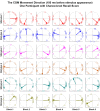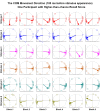The "Motor" in Implicit Motor Sequence Learning: A Foot-stepping Serial Reaction Time Task
- PMID: 29781982
- PMCID: PMC6101094
- DOI: 10.3791/56483
The "Motor" in Implicit Motor Sequence Learning: A Foot-stepping Serial Reaction Time Task
Abstract
This protocol describes a modified serial reaction time (SRT) task used to study implicit motor sequence learning. Unlike the classic SRT task that involves finger-pressing movements while sitting, the modified SRT task requires participants to step with both feet while maintaining a standing posture. This stepping task necessitates whole body actions that impose postural challenges. The foot-stepping task complements the classic SRT task in several ways. The foot-stepping SRT task is a better proxy for the daily activities that require ongoing postural control, and thus may help us better understand sequence learning in real-life situations. In addition, response time serves as an indicator of sequence learning in the classic SRT task, but it is unclear whether response time, reaction time (RT) representing mental process, or movement time (MT) reflecting the movement itself, is a key player in motor sequence learning. The foot-stepping SRT task allows researchers to disentangle response time into RT and MT, which may clarify how motor planning and movement execution are involved in sequence learning. Lastly, postural control and cognition are interactively related, but little is known about how postural control interacts with learning motor sequences. With a motion capture system, the movement of the whole body (e.g., the center of mass (COM)) can be recorded. Such measures allow us to reveal the dynamic processes underlying discrete responses measured by RT and MT, and may aid in elucidating the relationship between postural control and the explicit and implicit processes involved in sequence learning. Details of the experimental set-up, procedure, and data processing are described. The representative data are adopted from one of our previous studies. Results are related to response time, RT, and MT, as well as the relationship between the anticipatory postural response and the explicit processes involved in implicit motor sequence learning.
Similar articles
-
Implicit learning in Parkinson's disease: evidence from a verbal version of the serial reaction time task.J Clin Exp Neuropsychol. 1998 Jun;20(3):413-8. doi: 10.1076/jcen.20.3.413.826. J Clin Exp Neuropsychol. 1998. PMID: 9845167 Clinical Trial.
-
New insights into statistical learning and chunk learning in implicit sequence acquisition.Psychon Bull Rev. 2017 Aug;24(4):1225-1233. doi: 10.3758/s13423-016-1193-4. Psychon Bull Rev. 2017. PMID: 27812961
-
Beyond the mean reaction time: Trial-by-trial reaction time reveals the distraction effect on perceptual-motor sequence learning.Cognition. 2020 Sep;202:104287. doi: 10.1016/j.cognition.2020.104287. Epub 2020 Apr 27. Cognition. 2020. PMID: 32353467
-
Is implicit sequence learning impaired in schizophrenia? A meta-analysis.Brain Cogn. 2008 Aug;67(3):351-9. doi: 10.1016/j.bandc.2008.02.005. Epub 2008 Apr 18. Brain Cogn. 2008. PMID: 18378373
-
Implicit learning in individuals with autism spectrum disorders: a meta-analysis.Psychol Med. 2015 Apr;45(5):897-910. doi: 10.1017/S0033291714001950. Epub 2014 Aug 15. Psychol Med. 2015. PMID: 25126858 Review.
Cited by
-
Task integration in complex, bimanual sequence learning tasks.Psychol Res. 2024 Feb;88(1):207-221. doi: 10.1007/s00426-023-01848-2. Epub 2023 Jun 17. Psychol Res. 2024. PMID: 37329366 Free PMC article.
-
Multimodal mobile brain and body imaging for quantification of dance motor sequence learning.MethodsX. 2025 Apr 19;14:103324. doi: 10.1016/j.mex.2025.103324. eCollection 2025 Jun. MethodsX. 2025. PMID: 40331031 Free PMC article.
-
The feasibility and efficacy of a serial reaction time task that measures motor learning of anticipatory stepping.Gait Posture. 2021 May;86:346-353. doi: 10.1016/j.gaitpost.2021.04.002. Epub 2021 Apr 7. Gait Posture. 2021. PMID: 33857800 Free PMC article. Clinical Trial.
-
Optimizing Reaction Time in Relation to Manual and Foot Laterality in Children Using the Fitlight Technological Systems.Sensors (Basel). 2022 Nov 14;22(22):8785. doi: 10.3390/s22228785. Sensors (Basel). 2022. PMID: 36433379 Free PMC article.
-
The effect of reward on motor learning: different stage, different effect.Front Hum Neurosci. 2024 Mar 12;18:1381935. doi: 10.3389/fnhum.2024.1381935. eCollection 2024. Front Hum Neurosci. 2024. PMID: 38532789 Free PMC article. Review.
References
-
- Nissen MJ, Bullemer P. Attentional requirements of learning: Evidence from performance measures. Cognit Psychol. 1987;19(1):1–32.
-
- Willingham DB, Nissen MJ, Bullemer P. On the development of procedural knowledge. J Exp Psychol Learn Mem Cogn. 1989;15(6):1047–1060. - PubMed
-
- Du Y. Learning processes underlying implicit motor sequence acquisition in children and adults. University of Maryland; 2016. PhD thesis.
-
- Du Y, Clark JE. New insights into statistical learning and chunk learning in implicit sequence acquisition. Psychon Bull Rev. 2016. pp. 1–9. - PubMed
Publication types
MeSH terms
LinkOut - more resources
Full Text Sources
Other Literature Sources






